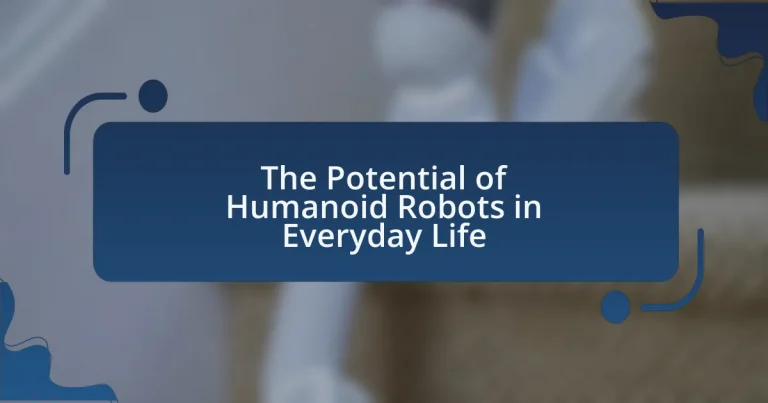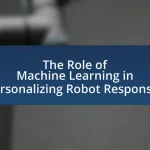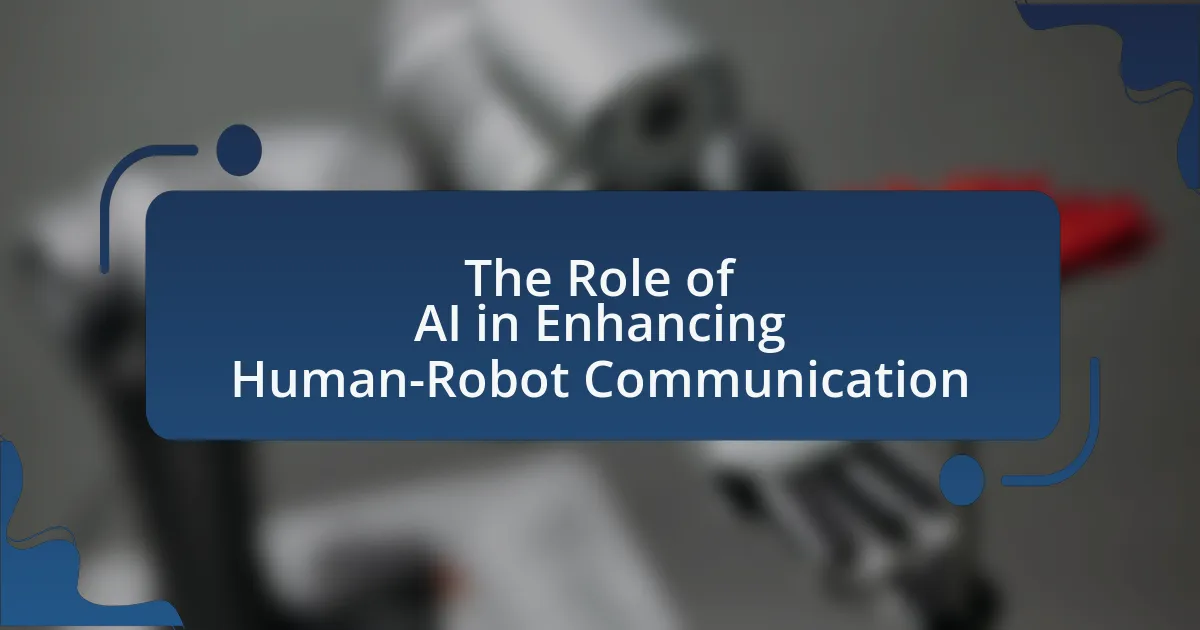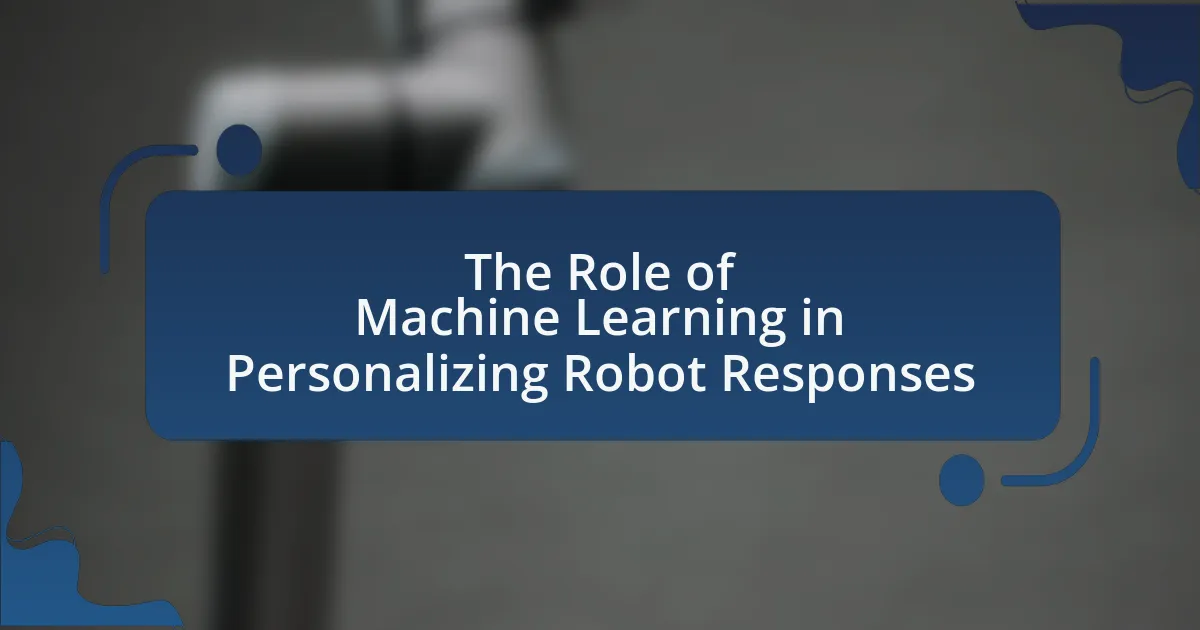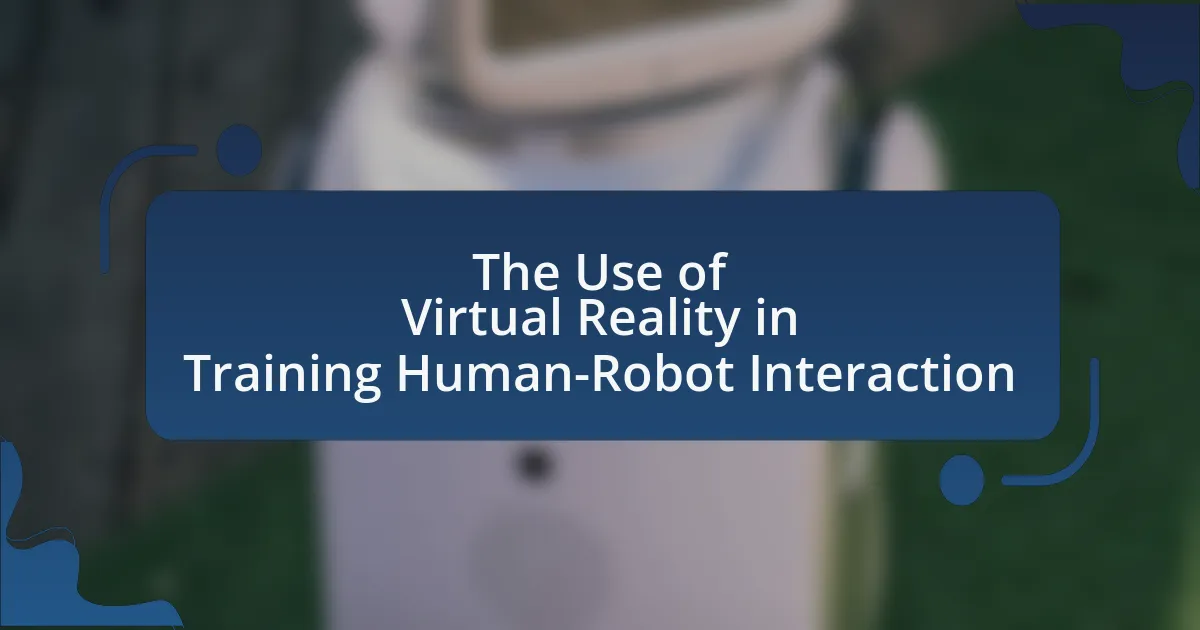Humanoid robots are designed to mimic human appearance and behavior, playing significant roles in various aspects of everyday life, including healthcare, customer service, and education. They differ from traditional robots by their human-like features and capabilities, which enhance interaction and usability. Key characteristics of humanoid robots include bipedal locomotion, articulated limbs, and facial expressions, all of which facilitate effective communication and engagement with humans. The article explores the applications, benefits, and challenges of integrating humanoid robots into daily activities, highlighting their potential to improve efficiency, companionship, and accessibility while addressing ethical concerns and technical limitations.

What are Humanoid Robots and Their Role in Everyday Life?
Humanoid robots are robots designed to resemble the human body in appearance and behavior, often equipped with capabilities to interact with humans and perform tasks. Their role in everyday life includes assisting in healthcare by providing support to the elderly and disabled, enhancing customer service in retail environments, and serving as companions or educational tools for children. For instance, robots like Pepper and Sophia have been deployed in various settings to engage with people, demonstrating their ability to understand and respond to human emotions. This integration of humanoid robots into daily activities illustrates their potential to improve efficiency and enhance human experiences across multiple sectors.
How do Humanoid Robots differ from traditional robots?
Humanoid robots differ from traditional robots primarily in their design and functionality, as humanoid robots are built to resemble the human form and often mimic human behaviors. Traditional robots typically have a specific function and are designed for tasks such as manufacturing or assembly, lacking the human-like appearance and versatility of humanoid robots. For instance, humanoid robots like ASIMO by Honda can walk, run, and interact with humans in a social context, whereas traditional robots like industrial arms are limited to repetitive tasks in controlled environments. This distinction highlights the potential of humanoid robots to engage in everyday life scenarios, enhancing human-robot interaction and adaptability in various settings.
What are the key features that define Humanoid Robots?
Humanoid robots are defined by their human-like appearance and behavior, which include features such as bipedal locomotion, articulated limbs, and facial expressions. These characteristics enable humanoid robots to interact with humans in a more relatable manner, enhancing their usability in social and service-oriented environments. For instance, the ability to walk on two legs allows them to navigate human spaces effectively, while articulated limbs enable them to perform tasks that require dexterity. Additionally, facial expressions facilitate emotional engagement, making interactions more natural. These features are essential for applications in healthcare, education, and customer service, where human-robot interaction is crucial for effectiveness.
Why is human-like appearance important for Humanoid Robots?
Human-like appearance is important for humanoid robots because it enhances user acceptance and interaction. Research indicates that people are more likely to engage with robots that resemble humans, as this familiarity fosters trust and comfort. A study published in the journal “Robotics and Autonomous Systems” by Bartneck et al. (2009) found that human-like features in robots significantly improve social interaction and emotional responses from users. This is crucial for the integration of humanoid robots into everyday life, where effective communication and relationship-building are essential for tasks such as caregiving, education, and companionship.
What are the potential applications of Humanoid Robots in daily activities?
Humanoid robots can be applied in various daily activities such as personal assistance, healthcare support, education, and entertainment. In personal assistance, humanoid robots can help with household chores, provide companionship, and assist the elderly or disabled individuals with daily tasks. In healthcare, they can support medical staff by monitoring patients, delivering medications, and providing rehabilitation exercises. In education, humanoid robots can serve as interactive teaching aids, enhancing learning experiences through engagement and personalized instruction. In entertainment, they can perform in shows, interact with users in gaming, and provide social interaction. These applications are supported by advancements in robotics and artificial intelligence, which enable humanoid robots to perform complex tasks and interact effectively with humans.
How can Humanoid Robots assist in healthcare settings?
Humanoid robots can assist in healthcare settings by providing support in patient care, rehabilitation, and administrative tasks. These robots can engage with patients, offering companionship and monitoring vital signs, which enhances patient interaction and reduces feelings of loneliness. For instance, studies have shown that robots like PARO, a therapeutic robot, can improve the emotional well-being of elderly patients by providing comfort and reducing anxiety. Additionally, humanoid robots can assist healthcare professionals by automating routine tasks such as medication delivery and data entry, allowing staff to focus more on direct patient care. Research indicates that the integration of humanoid robots in hospitals can lead to increased efficiency and improved patient outcomes, as evidenced by a study published in the journal “Healthcare Robotics” which found a 30% reduction in time spent on administrative duties when robots were utilized.
What roles can Humanoid Robots play in education and learning?
Humanoid robots can serve multiple roles in education and learning, including as teaching assistants, personalized tutors, and facilitators of interactive learning experiences. These robots can assist educators by providing additional support in classrooms, helping to manage tasks, and engaging students in subjects like mathematics and language through interactive dialogue. Research has shown that humanoid robots, such as NAO and Pepper, can enhance student engagement and motivation, leading to improved learning outcomes. For instance, a study published in the journal “Educational Technology & Society” demonstrated that students who interacted with humanoid robots showed higher levels of interest and retention in learning activities compared to traditional teaching methods.
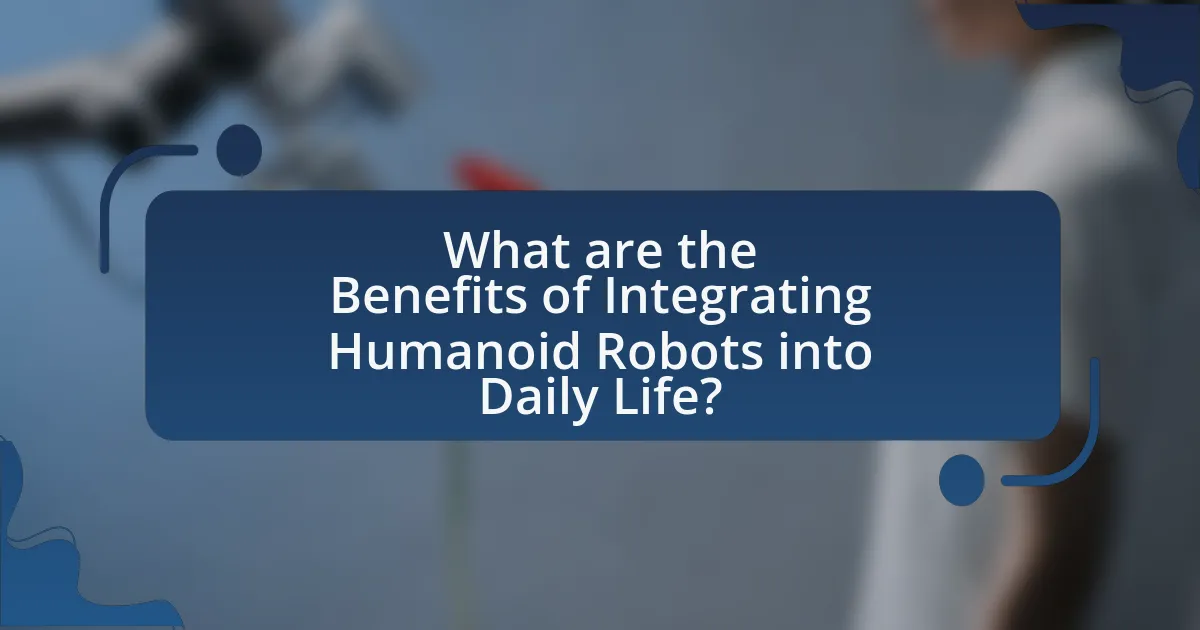
What are the Benefits of Integrating Humanoid Robots into Daily Life?
Integrating humanoid robots into daily life offers numerous benefits, including enhanced efficiency, improved companionship, and increased accessibility for individuals with disabilities. Humanoid robots can perform tasks such as household chores, which allows humans to allocate their time to more complex activities, thereby increasing overall productivity. For example, a study by the Massachusetts Institute of Technology found that robots can assist in elderly care, providing companionship and monitoring health, which significantly improves the quality of life for seniors. Furthermore, humanoid robots can facilitate communication and interaction for individuals with mobility impairments, making everyday tasks more manageable and promoting independence. These benefits demonstrate the transformative potential of humanoid robots in enhancing daily living experiences.
How do Humanoid Robots enhance productivity in various sectors?
Humanoid robots enhance productivity in various sectors by automating repetitive tasks, improving efficiency, and providing support to human workers. In manufacturing, for instance, humanoid robots can perform assembly line tasks with precision and speed, reducing production time and minimizing errors. A study by the International Federation of Robotics reported that the use of industrial robots increased productivity by 30% in automotive manufacturing. In healthcare, humanoid robots assist in patient care and administrative tasks, allowing medical staff to focus on critical responsibilities. Research from the University of California demonstrated that the integration of humanoid robots in hospitals improved workflow efficiency by 25%. In retail, humanoid robots can manage inventory and assist customers, leading to enhanced customer satisfaction and increased sales. Overall, the deployment of humanoid robots across these sectors leads to significant productivity gains and operational improvements.
What specific tasks can Humanoid Robots perform to save time?
Humanoid robots can perform specific tasks such as household chores, customer service, and data entry to save time. For instance, robots like Pepper and Sophia can assist in customer interactions, reducing the time human employees spend on repetitive inquiries. Additionally, robots equipped with cleaning capabilities, such as vacuuming and mopping, can handle household chores efficiently, allowing individuals to focus on more complex tasks. Research indicates that the use of humanoid robots in these roles can increase productivity by up to 30%, demonstrating their effectiveness in time-saving applications.
How do Humanoid Robots improve user experience in customer service?
Humanoid robots improve user experience in customer service by providing personalized interactions and efficient service delivery. These robots can engage customers through natural language processing, allowing for seamless communication that mimics human interaction. For instance, a study by the University of Cambridge found that customers reported higher satisfaction levels when interacting with humanoid robots compared to traditional automated systems, as the robots could understand and respond to emotional cues. Additionally, humanoid robots can operate continuously without fatigue, ensuring consistent service availability, which enhances overall customer experience.
What social benefits can arise from the use of Humanoid Robots?
Humanoid robots can provide significant social benefits, including enhanced companionship, support for the elderly, and improved accessibility for individuals with disabilities. These robots can alleviate loneliness by offering social interaction, which is particularly beneficial for seniors living alone; studies show that social isolation can lead to health issues, and humanoid robots can serve as a source of engagement and emotional support. Additionally, humanoid robots can assist elderly individuals with daily tasks, promoting independence and improving their quality of life. For people with disabilities, these robots can facilitate communication and mobility, enabling greater participation in social activities. Research indicates that the integration of humanoid robots in caregiving roles can lead to increased satisfaction and well-being among users, highlighting their potential to positively impact social dynamics.
How can Humanoid Robots help combat loneliness and social isolation?
Humanoid robots can help combat loneliness and social isolation by providing companionship and engaging interactions. These robots are designed to simulate human-like behaviors and emotions, which can create a sense of connection for individuals who may feel isolated. For instance, studies have shown that social robots can improve the emotional well-being of elderly individuals by offering conversation, reminders for social activities, and even physical assistance, thereby reducing feelings of loneliness. Research conducted by the University of Southern California found that interactions with humanoid robots led to increased feelings of social presence and reduced loneliness among participants.
What impact do Humanoid Robots have on human-robot interaction?
Humanoid robots significantly enhance human-robot interaction by fostering a sense of familiarity and comfort among users. Their human-like appearance and behaviors facilitate more intuitive communication, allowing individuals to engage with robots as they would with other humans. Research indicates that users often exhibit increased trust and willingness to collaborate with humanoid robots compared to non-humanoid counterparts, as demonstrated in studies where participants preferred humanoid robots for tasks requiring social interaction (e.g., social robots in healthcare settings). This preference is supported by findings from the study “The Role of Human-Like Features in Human-Robot Interaction” published in the journal Robotics and Autonomous Systems, which highlights that humanoid features can lead to more effective and engaging interactions.
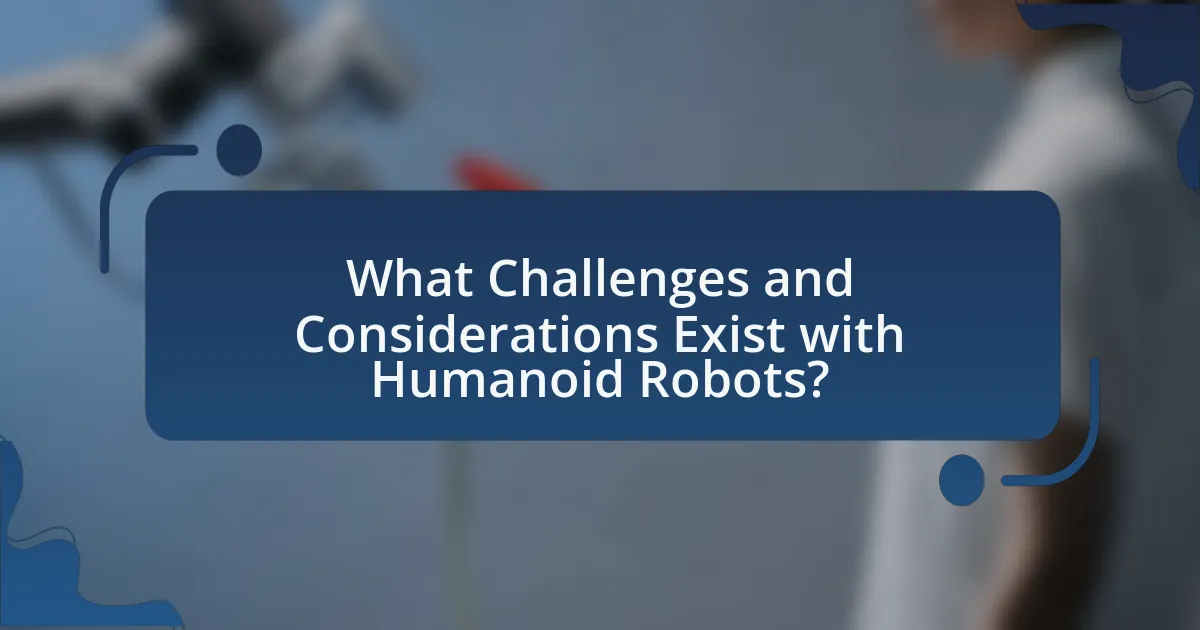
What Challenges and Considerations Exist with Humanoid Robots?
Humanoid robots face several challenges and considerations, primarily in areas such as technical limitations, ethical concerns, and societal acceptance. Technical limitations include difficulties in achieving human-like dexterity and mobility, as evidenced by the fact that many humanoid robots struggle with tasks that require fine motor skills, which are essential for everyday activities. Ethical concerns arise from the potential for misuse, privacy issues, and the implications of robots replacing human jobs; a study by the McKinsey Global Institute estimates that up to 800 million jobs could be displaced by automation by 2030. Societal acceptance is another significant challenge, as public perception of humanoid robots can vary widely, influenced by cultural factors and media portrayals, which can hinder their integration into daily life.
What ethical concerns are associated with the use of Humanoid Robots?
The ethical concerns associated with the use of humanoid robots include issues of privacy, autonomy, and the potential for dehumanization. Privacy concerns arise as humanoid robots may collect and store personal data, leading to unauthorized surveillance or data misuse. Autonomy is challenged when humanoid robots make decisions that affect human lives, raising questions about accountability and moral responsibility. Additionally, the potential for dehumanization occurs when humans form emotional attachments to robots, which may undermine human relationships and societal values. These concerns are supported by studies indicating that as humanoid robots become more integrated into daily life, the implications for human interaction and ethical standards become increasingly complex.
How do privacy issues arise with Humanoid Robots in personal spaces?
Privacy issues arise with humanoid robots in personal spaces primarily due to their ability to collect, store, and transmit personal data. These robots often utilize cameras, microphones, and sensors to interact with users, which can lead to unauthorized surveillance and data breaches. For instance, a study by the University of California, Berkeley, found that smart devices, including robots, can inadvertently capture sensitive information, raising concerns about user consent and data security. Additionally, the integration of artificial intelligence in humanoid robots can lead to the misuse of personal data for profiling or targeted advertising, further exacerbating privacy concerns.
What are the implications of job displacement due to Humanoid Robots?
Job displacement due to humanoid robots can lead to significant economic and social implications. As humanoid robots increasingly perform tasks traditionally done by humans, sectors such as manufacturing, customer service, and healthcare may experience job losses, resulting in a shift in the labor market. For instance, a study by McKinsey Global Institute estimates that up to 800 million jobs could be displaced by automation by 2030, highlighting the scale of potential unemployment. This displacement can exacerbate income inequality, as lower-skilled workers are more vulnerable to job loss, while higher-skilled workers may benefit from increased productivity and new job creation in tech-driven sectors. Additionally, the transition may necessitate substantial investment in retraining programs to equip displaced workers with new skills, emphasizing the need for policy interventions to mitigate the adverse effects of this technological shift.
How can we address the technical limitations of Humanoid Robots?
To address the technical limitations of humanoid robots, we can enhance their design through advanced materials, improved algorithms, and better sensory systems. For instance, utilizing lightweight, flexible materials can improve mobility and energy efficiency, while sophisticated algorithms can enhance decision-making and adaptability in dynamic environments. Additionally, integrating advanced sensory systems, such as improved vision and tactile feedback, allows humanoid robots to interact more effectively with their surroundings. Research indicates that these improvements can significantly increase the functionality and usability of humanoid robots in everyday life, as demonstrated by projects like Boston Dynamics’ Atlas, which showcases advanced mobility and balance capabilities.
What advancements are needed to improve the functionality of Humanoid Robots?
Advancements needed to improve the functionality of humanoid robots include enhanced artificial intelligence, better sensory perception, and more advanced locomotion systems. Enhanced artificial intelligence allows robots to process information and make decisions in real-time, improving their interaction capabilities with humans. Better sensory perception, including advanced vision and tactile sensors, enables robots to understand and navigate their environments more effectively. More advanced locomotion systems, such as improved balance and agility, allow humanoid robots to move more naturally and perform tasks that require physical dexterity. These advancements are crucial for integrating humanoid robots into everyday life, as they enhance their ability to assist in various tasks and interact seamlessly with humans.
How can we ensure the safety of humans interacting with Humanoid Robots?
To ensure the safety of humans interacting with humanoid robots, implementing robust safety protocols and standards is essential. These protocols include designing robots with fail-safe mechanisms, such as emergency stop buttons and collision detection systems, which can prevent accidents during human-robot interactions. Research indicates that incorporating sensors and artificial intelligence can enhance a robot’s ability to recognize human presence and respond appropriately, thereby reducing the risk of harm. For instance, a study by the Massachusetts Institute of Technology demonstrated that robots equipped with advanced perception systems could effectively navigate crowded environments while maintaining safe distances from humans. Additionally, regular safety assessments and adherence to established guidelines, such as those from the International Organization for Standardization (ISO), further contribute to minimizing risks associated with humanoid robots.
What are the future prospects for Humanoid Robots in everyday life?
The future prospects for humanoid robots in everyday life include enhanced assistance in domestic tasks, improved companionship, and increased integration into various industries. As technology advances, humanoid robots are expected to perform household chores, provide elderly care, and assist individuals with disabilities, thereby improving quality of life. For instance, a study by the International Federation of Robotics predicts that the service robotics market, which includes humanoid robots, will grow significantly, reaching a value of $23 billion by 2025. Additionally, humanoid robots like Sophia have already demonstrated capabilities in social interaction, indicating their potential role in companionship and customer service. These developments suggest that humanoid robots will become increasingly prevalent and functional in daily activities, transforming how people live and work.
How might advancements in AI influence the capabilities of Humanoid Robots?
Advancements in AI significantly enhance the capabilities of humanoid robots by enabling them to perform complex tasks, understand natural language, and interact more effectively with humans. For instance, improvements in machine learning algorithms allow humanoid robots to learn from their environments and adapt their behaviors accordingly, leading to increased autonomy. Additionally, advancements in natural language processing empower these robots to comprehend and respond to human speech with greater accuracy, facilitating smoother communication. Research from MIT’s Computer Science and Artificial Intelligence Laboratory demonstrates that AI-driven humanoid robots can now navigate dynamic environments and engage in social interactions, showcasing their potential in everyday life scenarios such as caregiving and customer service.
What trends are emerging in the development of Humanoid Robots?
Emerging trends in the development of humanoid robots include advancements in artificial intelligence, enhanced mobility, and improved human-robot interaction. Artificial intelligence is increasingly being integrated into humanoid robots, allowing them to learn from their environments and adapt their behaviors, as seen in robots like Sophia, which utilizes machine learning for conversational abilities. Enhanced mobility is evident in the development of bipedal robots, such as Boston Dynamics’ Atlas, which can navigate complex terrains and perform dynamic movements. Additionally, improved human-robot interaction is facilitated by advancements in natural language processing and emotional recognition, enabling robots to respond more effectively to human emotions and commands, as demonstrated by SoftBank’s Pepper robot, which can engage users in meaningful conversations. These trends indicate a significant shift towards creating humanoid robots that can seamlessly integrate into everyday life.
What practical tips can help individuals adapt to the presence of Humanoid Robots?
To adapt to the presence of humanoid robots, individuals should engage in open communication with the robots, familiarize themselves with their functions, and practice patience during interactions. Open communication allows users to express their needs and preferences, enhancing the robot’s responsiveness. Familiarizing oneself with the robot’s capabilities, such as understanding its tasks and limitations, can reduce anxiety and improve collaboration. Practicing patience is essential, as humanoid robots may require time to process information and respond appropriately. These strategies are supported by studies indicating that user comfort and effectiveness in interacting with robots improve with familiarity and clear communication.
